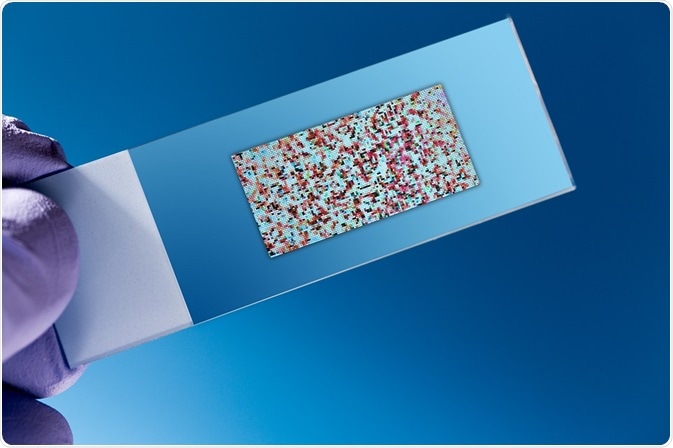Microarrays are a two-dimensional arrangement of biological samples, with samples placed in spots numbering in the thousands and organized into columns and rows. They allow for efficient analysis of genetic material and the most common type, DNA microarrays, have been utilized for large-scale studies of gene expression. The history of microarrays follows a path that links the groundbreaking discovery of the structure of DNA to contemporary studies of genetics.

Credit: sciencephoto/ Shutterstock.com
Early DNA arrays
After the first description of the double helix DNA structure by Watson and Crick in 1953, the process of separating the two strands was soon reversed with methods of DNA molecular hybridization quickly explored.
Molecular hybridization is the occurrence of single-stranded DNA binding to complimentary DNA. The complimentary base pairs that form the structure of the opposite strands of DNA are the foundation for all analysis methods involving DNA sequences.
In 1975, Grunstein and Hogness applied the process of molecular hybridization to DNA released from blotted microbial colonies, a useful process for screening bacteria clones. The colony hybridization method was formed by randomly cloning Escherichia coli (E. coli) DNA onto agar petri plates covered with nitrocellulose filters. A radioactively labeled probe was then added which would bind to complimentary DNA within the sample.
The aforementioned method formed a random orientation of sample DNA spots representing the cloned fragments of DNA. This is an early example of a labeled probe being utilized in order to identify complimentary base pair binding. It can therefore be considered as one of the first examples of a DNA array.
Gergan et al. adapted this methodology to produce arrays in 1979. Multiple plates on agar were replicated to produce arrays through the use of a mechanical 144 pin device for placing samples in the corresponding amount of well microplates. This allowed for the production of arrays for over a thousand different bacterial colonies.
The colonies could then be easily transferred to paper filters for the necessary lysis, denaturation and fixing steps for producing hybridized DNA. The technology of filter based arrays was used in research that led to the identification of single nucleotide polymorphisms (SNPs) and the ability to clone specific genes of interest.
The importance of automated arrays and cDNA cloning to microarray technology
The ability to analyze multiple hybridization targets was automated in the late 1980s and early 1990s. Robotic technology was used to quickly array clones from microtiter plates onto filters. The arrays created a defined pattern allowing parallel hybridizations to be produced.
Efficiency was increased with the errors that occur during repetitive procedures being reduced through the automated placing of samples on the array. The increased speed and accuracy from automation was an important step in the development towards microarrays.
A further development of complimentary DNA (cDNA) cloning was also an important foundation for the microarray, as it led to the creation of reference sets of cDNA and corresponding filter arrays for whole genomes.
Introduction of miniaturized microarrays
In 1995, the first study that used the word 'microarray' was published which explained how the expression of many genes could be monitored in parallel through the use of this new technology. The sample array was constructed through high-speed robotic printing of cDNA on glass.
The small size of spots on the array and high density of the arrays produced hybridization volumes of two microliters, which was the volume that enabled the detection of rare transcripts within the probe samples.
The microarray was a technical advancement that meant a broader examination of gene expression could be accomplished. In 1997, the researchers from Stanford University published the first whole-genome microarray study of gene expression by placing the whole yeast genome on a microarray.
The technology was not commercialized and the Stanford University laboratory published the instructions for producing the robotics necessary for a microarray. While today there are commercial microarray options with greater sensitivity, the simple production of microarrays has allowed for easily customizable experiments within laboratories.
Sources:
- https://www.ncbi.nlm.nih.gov/pmc/articles/PMC4011503/
- https://www.ncbi.nlm.nih.gov/pubmed/11357674
- https://j-biomed-discovery.biomedcentral.com/articles/10.1186/1747-5333-1-11
- https://www.ncbi.nlm.nih.gov/pubmed/7569999
- https://www.ncbi.nlm.nih.gov/pmc/articles/PMC24262/
Further Reading
Last Updated: May 24, 2019